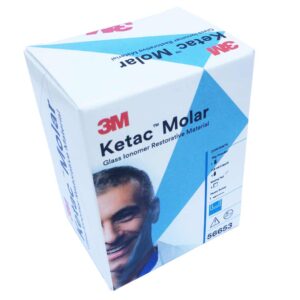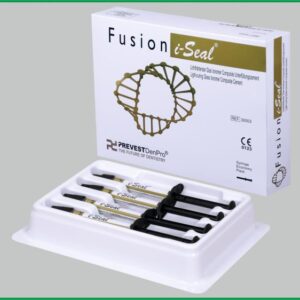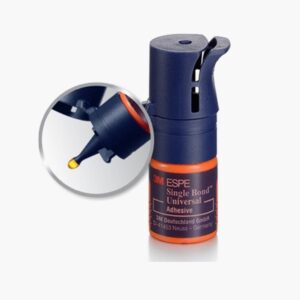Prevest Denpro Fusion Universal Composite Kit
10 in stock
- Light Cured Universal Nano Hybrid Composite
Starting at: $1440.00
| Prevest Denpro | Prevest Fusion Universal Composite Master Kit (7 syringes) |
$2400.00 |
-
+
|
In Stock | ||
| Prevest Denpro | Prevest Fusion Universal Composite Intro Kit (4 syringes) |
$1440.00 |
-
+
|
In Stock |
It is a visible light cured, radiopaque highly filled, nano filled hybrid composite restorative material for all cavity classes of anterior and posterior teeth.
INDICATIONS
* Direct Restoration of all cavity classes in anterior and posterior teeth.
* Preventive polymerization and repairs of composite ceramic veneers.
* Correction of shade and shade for better aesthetics.
* Core build-up & Composite inlays
ADVANTAGES
* Excellent physical properties for long lasting restorations.
* Lower polymerization shrinkage than conventional composites.
* Higher filler contents.
* Extremely high abrasion resistance.
COMPOSITION
Bisphenol A Glycidyl methacrylate
Bisphenol a diethoxy methacrylate
Urethane dimethacrylate
Triethylene gycol dimethacrylate
Silanated barium glass powder
Amorphous fumed silica
Diferences between different types of composite fillers
| Microfills | Microhybrid | Nanohybrid | |
| Particle size | 0.01 to 0.1 µm (agglomerated) | 1- 0.1- to 2-µm glass
2- 40-nm silica |
1- 0.1- to 2-µm glass or resin micro particles
2- ≤100-nm nanoparticles |
| Clinical use | · Sub gingival lesions
· Smooth surfaces · Anterior aesthetic |
w.r.t (1) Moderate-stress areas requiring optimal polishability (Classes III, IV) | Wrt (1) Moderate-stress areas requiring optimal Polishability
w.r.t (2) (Classes III, IV) |
| Advantages | · Simulates actual enamel surface
· Highest aesthetic level · Better wear properties than any other · High luster and hold their polish over time · Stain and plaque resistant · Highest reflective and refractive indices hence more realistic translucency |
· Simulate the dentin of natural tooth structure.
· Higher strength can be used as substructure under microfills enamel layer. · Most Opaque of the 3 composite types, also great for masking out unwanted color and achieving extreme color changes. |
· exhibit higher polishability
· better surface smoothness · lifelike opacious translucency |
| Disadvantages | · Less strength than micro and nanohybrid
· Dec. water sorption |
· Less polishable
· More difficult to marginate, and will wear faster than microfill resins.
|
· donot hold their polish long as microfills but better than microhybrids
· More susceptible to plaque and staining over time. · Less biological compatible with gingival tissues
|
| Indications | · Class III & calss V | · Anterior and posterior restorations
· Can be used to fill the bulk of the tooth |
· posterior restorations
· veneering manidbular anteriors · building up incisal edges · class IV restoration · increasing cuspid rise · when the doctor wants to use only one material |
CONTRAINDICATIONS
If allergic to methacrylate resins. Avoid prolonged inhalation and contact with skin.
STORAGE CONDITIONS
store between 10’ to 25’C. Keep away from moisture.
SHELF LIFE
3 years from date of manufacturing
PRECAUTIONS
Eugenol containing materials should not be used with this material because they may effect polymerization and interfere with the hardening process. Being sensitive to heat and light, the syringes should be kept away from direct heat and light.
Features
- Extremely high abrasion resistance
- Higher filler contents
- Excellent physical properties for long lasting restorations
- Lower polymerization shrinkage than conventional composites.
Directions To Use
Instructions for use :
Step 1– Clean the tooth to be treated and adjacent teeth with a brush and prophy paste and select the shade using Shade Guide.
Step 2- Prepare the cavity
(No residual amalgam or other base material should be left in the cavity)
Step3- Apply Actino 37% Phosphoric Acid Etchant Gel for 15-20 sec.
Remove Gel with vigorous water spray and rinse conditioned area for at least 10 sec.
Blot dry conditioned area with a moist cotton pellet.
Step 4- Apply Fusion Bond 5 dentine bonding agent with a disposable brush to the entire cavity.
Ensure thorough wetting of the entire cavity.
Allow 20 sec air drying and re apply another coat of dentine bonding agent.
Remove excess solvent by gently drying with dry air for at least 5sec to ensure uniform glossy surface.
Cure adhesive for 20-30 sec using standard curing light.
Step 5- Dispense the material using shaping instruments. Contour the material in the cavity. Light cure for 40 sec using standard curing light. When necessary build in increments of 2mm maximum using a layering technique. Shape and polish using standard technique and at last stage apply Nano Coat protective varnish.
Packaging
Master Kit :-
- 7 X 4g syringes (A1.A2. A3.A3.5. B1. B2. B3)
- 1 x 5ml Bottle Fusion Bond 5
- 1 x 2 ml syringe Actino Etchant Gel
- 10 x Micro Brushes
- 10 x Applicators Tips
- Instruction Manual
Intro Kit :-
- 4 x 4g Syringes (A2, A3, B2, B3)
- 1 x 5ml Fusion Bond 5
- 1 x 2ml Syringe Actino Etching Gel
- 10 x Micro Brushes
- 10 x Applicator Tips
FAQs
1. Is the finished product stable over time (15 to 20 years) or how strong is the restoration?
-Although, nanohybrids show higher strength, it equally depends on dentist’s technical ability
2. What are the translucency and opacity characteristics of the material?
-Less opacious than microhybrids, nonetheless posess lifelife opacious translucency.
3. When finished properly, are the composite and gingival tissues biocompatible?
-Microfills are the most biocompatible as compared to nano and microhybrids
4. What material has adequate strength for the purpose of use?
-Microhybrids posess higher strength than nanohybrids.
5. What material is more wear resistant? Why?
-Among all 3 types of composites resin materials, microfills are the most wear resistant.





















Dr Rajat Sood –
Excellent physical properties for long lasting restorations Excellent composite kit . Have great experience with it
Dr Rajat Sood –
Dr. Anuj Uppal –
Excellent product at such a low cost. I appreciate the quick arrival.
Dr. Anuj Uppal –